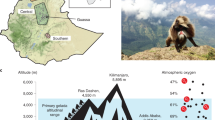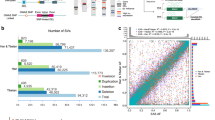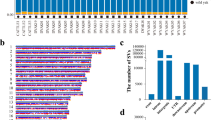Abstract
Zokors, an Asiatic group of subterranean rodents, originated in lowlands and colonized high-elevational zones following the uplift of the Qinghai–Tibet plateau about 3.6 million years ago. Zokors live at high elevation in subterranean burrows and experience hypobaric hypoxia, including both hypoxia (low oxygen concentration) and hypercapnia (elevated partial pressure of CO2). Here we report a genomic analysis of six zokor species (genus Eospalax) with different elevational ranges to identify structural variants (deletions and inversions) that may have contributed to high-elevation adaptation. Based on an assembly of a chromosome-level genome of the high-elevation species, Eospalax baileyi, we identified 18 large inversions that distinguished this species from congeners native to lower elevations. Small-scale structural variants in the introns of EGLN1, HIF1A, HSF1 and SFTPD of E. baileyi were associated with the upregulated expression of those genes. A rearrangement on chromosome 1 was associated with altered chromatin accessibility, leading to modified gene expression profiles of key genes involved in the physiological response to hypoxia. Multigene families that underwent copy-number expansions in E. baileyi were enriched for autophagy, HIF1 signalling and immune response. E. baileyi show a significantly larger lung mass than those of other Eospalax species. These findings highlight the key role of structural variants underlying hypoxia adaptation of high-elevation species in Eospalax.
This is a preview of subscription content, access via your institution
Access options
Access Nature and 54 other Nature Portfolio journals
Get Nature+, our best-value online-access subscription
$29.99 / 30 days
cancel any time
Subscribe to this journal
Receive 12 digital issues and online access to articles
$119.00 per year
only $9.92 per issue
Buy this article
- Purchase on Springer Link
- Instant access to full article PDF
Prices may be subject to local taxes which are calculated during checkout




Similar content being viewed by others
Data availability
DNA sequence data are available from NCBI SRA under BioProject accession PRJNA947478. The RNA sequence data reported in this paper are deposited in the Genome Sequence Archive in National Genomics Data Center, China National Center for Bioinformation/Beijing Institute of Genomics, Chinese Academy of Sciences (PRJCA019941: CRA012698), which are publicly accessible at https://ngdc.cncb.ac.cn/gsa. The chromosomal level genome assembly and annotation reported in this paper are deposited in the China National GeneBank DataBase (https://db.cngb.org) with BioProject ID CNP0005002 and uploaded in figshare (https://doi.org/10.6084/m9.figshare.24085119). Source data are provided with this paper.
Code availability
The code used for the analyses is available from GitHub (https://github.com/anxuan-web/Structural-variants-in-Eospalax).
References
Chiou, K. L. et al. Genomic signatures of high-altitude adaptation and chromosomal polymorphism in geladas. Nat. Ecol. Evol. 6, 630–643 (2022).
Cai, Z. et al. Adaptive transcriptome profiling of subterranean Zokor, Myospalax baileyi, to high-altitude stresses in Tibet. Sci. Rep. 8, 4671 (2018).
Zhang, T. et al. Phenotypic and genomic adaptations to the extremely high elevation in plateau zokor (Myospalax baileyi). Mol. Ecol. 30, 5765–5779 (2021).
Simonson, T. S. et al. Genetic evidence for high-altitude adaptation in Tibet. Science 329, 72–75 (2010).
Yi, X. et al. Sequencing of 50 human exomes reveals adaptation to high altitude. Science 329, 75–78 (2010).
Peng, Y. et al. Genetic variations in Tibetan populations and high-altitude adaptation at the Himalayas. Mol. Biol. Evol. 28, 1075–1081 (2011).
Peng, Y. et al. Down-regulation of EPAS1 transcription and genetic adaptation of Tibetans to high-altitude hypoxia. Mol. Biol. Evol. 34, 818–830 (2017).
Huerta-Sánchez, E. et al. Genetic signatures reveal high-altitude adaptation in a set of Ethiopian populations. Mol. Biol. Evol. 30, 1877–1888 (2013).
Schweizer, R. M. et al. Physiological and genomic evidence that selection on the transcription factor Epas1 has altered cardiovascular function in high-altitude deer mice. PLoS Genet. 15, e1008420 (2019).
Schweizer, R. M. et al. Broad concordance in the spatial distribution of adaptive and neutral genetic variation across an elevational gradient in deer mice. Mol. Biol. Evol. 38, 4286–4300 (2021).
Scott, G. R. et al. Adaptive modifications of muscle phenotype in high-altitude deer mice are associated with evolved changes in gene regulation. Mol. Biol. Evol. 32, 1962–1976 (2015).
Storz, J. F. High-altitude adaptation: mechanistic insights from integrated genomics and physiology. Mol. Biol. Evol. 38, 2677–2691 (2021).
Storz, J. F. & Cheviron, Z. A. Physiological genomics of adaptation to high-altitude hypoxia. Annu. Rev. Anim. Biosci. 9, 149–171 (2021).
McClelland, G. B. & Scott, G. R. Evolved mechanisms of aerobic performance and hypoxia resistance in high-altitude natives. Annu. Rev. Physiol. 81, 561–583 (2019).
Storz, J. F. & Scott, G. R. Life ascending: mechanism and process in physiological adaptation to high-altitude hypoxia. Annu. Rev. Ecol., Evol. Syst. 50, 503 (2019).
Storz, J. F. et al. Evolution of physiological performance capacities and environmental adaptation: insights from high-elevation deer mice (Peromyscus maniculatus). J. Mammal. 100, 910–922 (2019).
Stewart, N. B. & Rogers, R. L. Chromosomal rearrangements as a source of new gene formation in Drosophila yakuba. PLoS Genet. 15, e1008314 (2019).
Shi, J. et al. Structural variants involved in high-altitude adaptation detected using single-molecule long-read sequencing. Nat. Commun. 14, 8282 (2023).
Quan, C. et al. Characterization of structural variation in Tibetans reveals new evidence of high-altitude adaptation and introgression. Genome Biol. 22, 159 (2021).
Almarri, M. A. et al. Population structure, stratification, and introgression of human structural variation. Cell 182, 189–199. e115 (2020).
Mérot, C. et al. A roadmap for understanding the evolutionary significance of structural genomic variation. Trends Ecol. Evol. 35, 561–572 (2020).
Villoutreix, R. et al. Large-scale mutation in the evolution of a gene complex for cryptic coloration. Science 369, 460–466 (2020).
Yan, Z. et al. Evolution of a supergene that regulates a trans-species social polymorphism. Nat. Ecol. Evol. 4, 240–249 (2020).
Hager, E. R. et al. A chromosomal inversion contributes to divergence in multiple traits between deer mouse ecotypes. Science 377, 399–405 (2022).
Harringmeyer, O. S. & Hoekstra, H. E. Chromosomal inversion polymorphisms shape the genomic landscape of deer mice. Nat. Ecol. Evol. 6, 1–15 (2022).
Shams, I. et al. Oxygen and carbon dioxide fluctuations in burrows of subterranean blind mole rats indicate tolerance to hypoxic-hypercapnic stresses. Comp. Biochem. Physiol. A 142, 376–382 (2005).
Liu, X. et al. Genomic insights into zokors’ phylogeny and speciation in China. Proc. Natl Acad. Sci. USA 119, e2121819119 (2022).
Storz, J. F. & Bautista, N. M. Altitude acclimatization, hemoglobin-oxygen affinity, and circulatory oxygen transport in hypoxia. Mol. Asp. Med. 84, 101052 (2022).
Partha, R. et al. Subterranean mammals show convergent regression in ocular genes and enhancers, along with adaptation to tunneling. eLife 6, e25884 (2017).
Davies, K. T. J. et al. Limited evidence for parallel molecular adaptations associated with the subterranean niche in mammals: a comparative study of three superorders. Mol. Biol. Evol. 35, 2544–2559 (2018).
Chang, L. et al. Akr1c1 connects autophagy and oxidative stress by interacting with sqstm1 in a catalytic-independent manner. Acta Pharmacol. Sin. 43, 703–711 (2022).
Bochud, M. et al. Association of CYP3A5 genotypes with blood pressure and renal function in African families. J. Hypertens. 24, 923–929 (2006).
Martinez, C. et al. Expression of paclitaxel-inactivating CYP3A activity in human colorectal cancer: implications for drug therapy. Br. J. Cancer 87, 681–686 (2002).
Jain, I. H. et al. Genetic screen for cell fitness in high or low oxygen highlights mitochondrial and lipid metabolism. Cell 181, 716–727. e711 (2020).
Brutsaert, T. D. et al. Association of EGLN1 gene with high aerobic capacity of Peruvian Quechua at high altitude. Proc. Natl Acad. Sci. USA 116, 24006–24011 (2019).
Chien, T. et al. GSK3β negatively regulates TRAX, a scaffold protein implicated in mental disorders, for NHEJ-mediated DNA repair in neurons. Mol. Psychiatry 23, 2375–2390 (2018).
Ostertag, E. M. & Kazazian, H. H. Twin priming: a proposed mechanism for the creation of inversions in L1 retrotransposition. Genome Res. 11, 2059–2065 (2001).
Yang, J. et al. Genetic signatures of high-altitude adaptation in Tibetans. Proc. Natl Acad. Sci. USA 114, 4189–4194 (2017).
Hu, L. et al. Arctic introgression and chromatin regulation facilitated rapid Qinghai-Tibet Plateau colonization by an avian predator. Nat. Commun. 13, 6413 (2022).
Davies, K. T. et al. Family wide molecular adaptations to underground life in African mole-rats revealed by phylogenomic analysis. Mol. Biol. Evol. 32, 3089–3107 (2015).
Hsia, C. C. et al. Enhanced alveolar growth and remodeling in guinea pigs raised at high altitude. Respir. Physiol. Neurobiol. 147, 105–115 (2005).
Llapur, C. J. et al. Increased lung volume in infants and toddlers at high compared to low altitude. Pediatr. Pulmonol. 48, 1224–1230 (2013).
Li, J. et al. A new homotetramer hemoglobin in the pulmonary surfactant of plateau zokors (Myospalax Baileyi). Front. Genet. 13, 824049 (2022).
Cimmino, F. et al. HIF-1 transcription activity: HIF1A driven response in normoxia and in hypoxia. BMC Med. Genet. 20, 37 (2019).
Aggarwal, S. et al. EGLN1 involvement in high-altitude adaptation revealed through genetic analysis of extreme constitution types defined in Ayurveda. Proc. Natl Acad. Sci. USA 107, 18961–18966 (2010).
Parathath, S. et al. Hypoxia is present in murine atherosclerotic plaques and has multiple adverse effects on macrophage lipid metabolism. Circ. Res. 109, 1141–1152 (2011).
Mendillo, M. L. et al. HSF1 drives a transcriptional program distinct from heat shock to support highly malignant human cancers. Cell 150, 549–562 (2012).
Santagata, S. et al. High levels of nuclear heat-shock factor 1 (HSF1) are associated with poor prognosis in breast cancer. Proc. Natl Acad. Sci. USA 108, 18378–18383 (2011).
Gottschling, D. E. et al. Position effect at S. cerevisiae telomeres: reversible repression of Pol II transcription. Cell 63, 751–762 (1990).
Nimmo, E. R. et al. Telomere-associated chromosome breakage in fission yeast results in variegated expression of adjacent genes. EMBO J. 13, 3801–3811 (1994).
Wang, J. et al. A heterochromatin domain forms gradually at a new telomere and is dynamic at stable telomeres. Mol. Cell. Biol. 38, e00393–17 (2018).
Samonte, R. V. & Eichler, E. E. Segmental duplications and the evolution of the primate genome. Nat. Rev. Genet. 3, 65–72 (2002).
Porubsky, D. et al. Recurrent inversion polymorphisms in humans associate with genetic instability and genomic disorders. Cell 185, 1986–2005. e1926 (2022).
Zhang, T. et al. Phylogenetic relationships of the zokor genus Eospalax (Mammalia, Rodentia, Spalacidae) inferred from whole-genome analyses, with description of a new species endemic to Hengduan Mountains. Zool. Res. 43, 331–342 (2022).
Kielbasa, S. M. et al. Adaptive seeds tame genomic sequence comparison. Genome Res. 21, 487–493 (2011).
Acknowledgements
We thank members of the Hoekstra laboratory for commenting on the paper. We thank X. Luo from the Kunming Institute of Zoology. This project was supported by the National Natural Science Foundation of China (grants 32271691 and 32071487 to K.L.), the National Key Research and Development Programs (grant 2021YFD1200901 to K.L.), the Fundamental Research Funds for Central Universities, LZU (grants lzujbky-2021-ey17 to K.L. and lzujbky-2022-it01 to Y.W.), the Science Fund for Creative Research Groups of Gansu Province (grant 21JR7RA533 to K.L.), Lanzhou University’s ‘Double First-Class’ Guided Project-Team Building Funding-Research Startup Fee for K. Li, a grant from State Key Laboratory of Herbage Improvement and Grassland Agro-ecosystems (Lanzhou University) (grant SKLGAE-202001, -202009 and -202010 to K.L.) and the Key Basic Research Project of Qinghai Provincial Department of Science and Technology (grant 2022-ZJ-733 to Q.X.). We received support for computational work from the Big Data Computing Platform for Western Ecological Environment and Regional Development and Supercomputing Center of Lanzhou University.
Author information
Authors and Affiliations
Contributions
X.A., X. Liu., Z.Q. and N.W. collected the samples. X.A., L.M., Y.W., Q.X., X. Liu., S.Z., Z.Q., B.L., F.L., Z.K., N.W., X. Liang., Q.D., Z.F., X.Y. and S.L. performed the data analyses. X.A., E.N., J.L., J.F.S. and K.L. wrote the paper. K.L. designed this study. All authors read, revised and approved the final paper.
Corresponding authors
Ethics declarations
Competing interests
The authors declare no competing interests.
Peer review
Peer review information
Nature Ecology & Evolution thanks Erica Heinrich and the other, anonymous, reviewer(s) for their contribution to the peer review of this work. Peer reviewer reports are available.
Additional information
Publisher’s note Springer Nature remains neutral with regard to jurisdictional claims in published maps and institutional affiliations.
Extended data
Extended Data Fig. 1 Genome assembly and annotation of E. baileyi (plateau zokor v3.0).
(a) Full karyotype of a female E. baileyi. (b) Example G-banded chromosome spread with 62 counted chromosomes. (c-d) Genome assembly and annotated genes completeness were evaluated by BUSCO. (e) Heatmap of the E. baileyi chromosome-level genome interaction matrix. (f) MCMCTree was constructed with nine rodent species. Arrows indicate species living underground.
Extended Data Fig. 2 SV (<1 Mb) dataset summary (LR-SV and SR-SV).
(a) The quantity and kinds of SVs were displayed as stacked bar graphs based on short-read sequencing. Bars and dots of various hues denote the type of variation and each species, respectively. (b) Diagram of length distribution for various types of SVs shorter than 10,000 bp. (c) The length distribution of INDELs generated from different sequencing platforms. (d) Annotation of repeat sequences of the LR-SV. (e) The genomic coordinates of LR-SV.
Extended Data Fig. 3 SV (>1 Mb) dataset summary (LR-SV and SR-SV).
The dark blue line at the top of each panel represents the genome of E. fontanierii, while the dark orange line represents the genome of E. baileyi. The orange block in each panel denotes the inversion position. Each panel (a-m) was one of 32 pseudochromosomes.
Extended Data Fig. 4 SV (<1 Mb) dataset summary (LR-SV and SR-SV).
(a) Contigs from de novo genome assemblies (‘query’, y-axis) were aligned to the E. fontanierii reference genome (‘reference’, x-axis). Contigs (blue) and those identifying inversion breakpoints (red) are shown. Predicted inversion boundaries are highlighted (purple box), showing predicted inversion (arrow) above. (b) The Synteny comparison between the genomes of E. fontanierii and E. baileyi showed that part of the contig of E. baileyi was reversed and the other contig was positive.
Extended Data Fig. 5 SV (<1 Mb) dataset summary (LR-SV and SR-SV).
The fixed-SV related differentially expressed genes in the lung (a) liver (b), and heart (c) of E. baileyi. Negative binomial distribution model and generalized linear model were used to identify DEGs, and we multiple-corrected using Benjamini-Hochberg model (padj ≤ 0.05). (d) GO enrichment terms of fixed SV-related genes typically in E. baileyi. (e) Enrichment of genes associated with E. baileyi-specific SVs, E. smithi-specific SVs and the shared SVs between the two species (Hypergeometric test, p < 0.05; Benjamini-Hochberg model, q < 0.05).
Extended Data Fig. 6 SV-related genes were involved in hypoxia adaptation.
(a) The frequency of inversion (2,212 bp) in HIF1A in Eospalax. (b) The nucleotide sequence and amino acid sequence of SFTPD in E. baileyi reveal a loss of one exon and 55 amino acids. De novo prediction of protein structure for E. fontanierii and E. baileyi. (c) A 1,989 bp intronic deletion in UVRAG was validated by coverage of reads. (d) Map and coverage of reads of deletion in XRCC4.
Extended Data Fig. 7 Three-dimensional genomics and divergence time of the rearrangement on chromosome 1.
(a) Compartment A/B, gene density and GC content of chromosome 1 in E. fontanierii and E. baileyi. A/B compartments are determined by the PC1 value, the red bar indicates compartment A and the blue bar indicates compartment B. (b) Topologically associating domains (TAD) insulation score of chromosome 1 in E. fontanierii and E. baileyi. (c) Venn diagram showing species-specific and shared TADs in SV regions and background regions. (d) Two E. baileyi-specific TADs associated hypoxia adaptation. (e) The number of shared/species-specific significant interaction regions between E. fontanierii and E. baileyi in the rearrangement region.
Extended Data Fig. 8 Three-dimensional genomics and divergence time of the rearrangement on chromosome 1.
(a) The overlap of inversions (< 1 Mb) with different types of repeats. Different colors represent different repeat sequence types. The X-axis of each figure represents the percentage of the length of the inverted sequence overlapped with different types of repeats as a percentage of the length of the inverted sequence. The Y-axis represents the number of inversions. (b) The type and proportion of repeated sequences in inversion (< 1 Mb). The x-coordinate represents the ratio of LINE1 to each inversion sequence. (c) Examples of inversions with inverted repeats at both breakpoints on chromosomes 1, 2, 3, 6, 8, 9, 11, 17, 21, 23, 24, 27 and 31. Dotplot depicts the inverted repeats near each inversion breakpoint. Locations of breakpoints are denoted by orange arrows, and only alignments longer than 100 bp and within 1 Mb of the breakpoints are displayed. Inverted repeats located within 1 Mb of both breakpoints are depicted (red) and highlighted (purple box). (d) The pie shows the number of inversions (> 1 Mb) that have at least one pair of inverted repeats at both inversion breakpoints. The histogram shows the length of inverted repeats near breakpoints. (e) Segmental duplication (SD) percentage of randomly selected 1 Mb regions across the genome and inversion (>1 Mb) regions.
Supplementary information
Source data
Source Data Extended Data Table 1
FDR value of genefamily analysis (cafe) in E. baileyi.
Source Data Extended Data Table 2
Statistics of RNA-seq data using mashr.
Rights and permissions
Springer Nature or its licensor (e.g. a society or other partner) holds exclusive rights to this article under a publishing agreement with the author(s) or other rightsholder(s); author self-archiving of the accepted manuscript version of this article is solely governed by the terms of such publishing agreement and applicable law.
About this article
Cite this article
An, X., Mao, L., Wang, Y. et al. Genomic structural variation is associated with hypoxia adaptation in high-altitude zokors. Nat Ecol Evol 8, 339–351 (2024). https://doi.org/10.1038/s41559-023-02275-7
Received:
Accepted:
Published:
Issue Date:
DOI: https://doi.org/10.1038/s41559-023-02275-7
This article is cited by
-
Exciting times for evolutionary biology
Nature Ecology & Evolution (2024)



